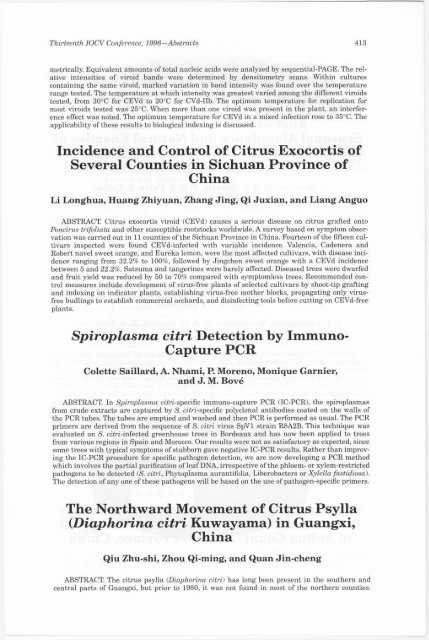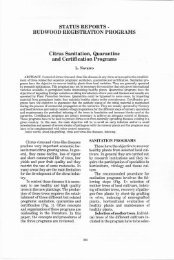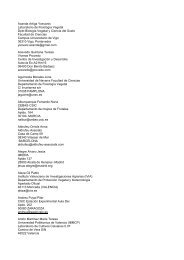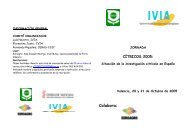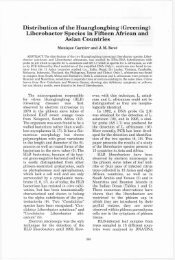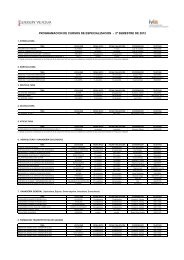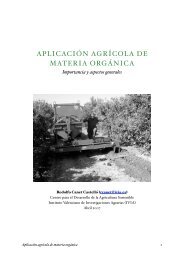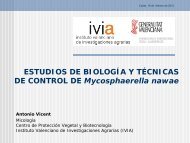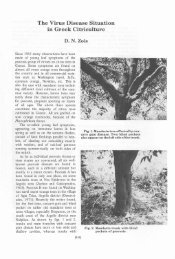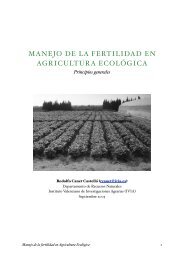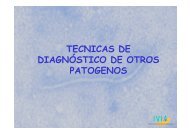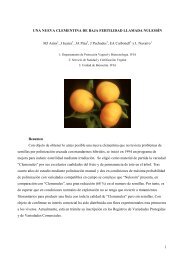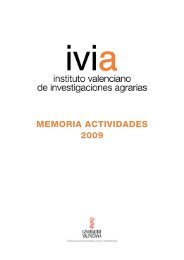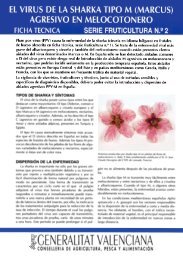ABSTRACTS Defective RNA Molecules Associated with Citrus ... - IVIA
ABSTRACTS Defective RNA Molecules Associated with Citrus ... - IVIA
ABSTRACTS Defective RNA Molecules Associated with Citrus ... - IVIA
Create successful ePaper yourself
Turn your PDF publications into a flip-book with our unique Google optimized e-Paper software.
Thirteenth IOCV Conference, 1996-Abstracts 413<br />
metrically. Equivalent amounts of total nucleic acids were analyzed by sequential-PAGE. The relative<br />
intensities of viroid bands were determined by densitometry scans. Within cultures<br />
containing the same viroid, marked variation in band intensity was found over the temperature<br />
range tested. The temperature at which intensity was greatest varied among the different viroids<br />
tested, from 30°C for CEVd to 20°C for CVd-IIb. The optimum temperature for replication for<br />
most viroids tested was 25°C. When more than one viroid was present in the plant, an interference<br />
effect was noted. The optimum temperature for CEVd in a mixed infection rose to 35OC. The<br />
applicability of these results to biological indexing is discussed.<br />
Incidence and Control of <strong>Citrus</strong> Exocortis of<br />
Several Counties in Sichuan Province of<br />
China<br />
Li Longhua, Huang Zhiyuan, Zhang Jing, Qi Juxian, and Liang Anguo<br />
ABSTRACT. <strong>Citrus</strong> exocortis viroid (CEVd) causes a serious disease on citrus grafted onto<br />
Poncirus trifoliata and other susceptible rootstocks worldwide. A survey based on symptom observation<br />
was carried out in 11 counties of the Sichuan Province in China. Fourteen of the fifteen cultivars<br />
inspected were found CEVd-infected <strong>with</strong> variable incidence. Valencia, Cadenera and<br />
Robert navel sweet orange, and Eureka lemon, were the most affected cultivars, <strong>with</strong> disease incidence<br />
ranging from 32.2% to loo%, followed by Jingchen sweet orange <strong>with</strong> a CEVd incidence<br />
between 5 and 22.2%. Satsuma and tangerines were barely affected. Diseased trees were dwarfed<br />
and fruit yield was reduced by 50 to 70% compared <strong>with</strong> symptomless trees. Recommended control<br />
measures include development of virus-free plants of selected cultivars by shoot-tip grafting<br />
and indexing on indicator plants, establishing virus-free mother blocks, propagating only virusfree<br />
budlings to establish commercial orchards, and disinfecting tools before cutting on CEVd-free<br />
plants.<br />
Spiroplasma citri Detection by Immuno-<br />
Capture PCR<br />
Colette Saillard, A. Nhami, P. Moreno, Monique Garnier,<br />
and J. M. Bov6<br />
ABSTRACT. In Spiroplasma citri-specific immuno-capture PCR (IC-PCR), the spiroplasmas<br />
from crude extracts are captured by S. citri-specific polyclonal antibodies coated on the walls of<br />
the PCR tubes. The tubes are emptied and washed and then PCR is performed as usual. The PCR<br />
primers are derived from the sequence of S. citri virus SpVl strain R8A2B. This technique was<br />
evaluated on S. citri-infected greenhouse trees in Bordeaux and has now been applied to trees<br />
from various regions in Spain and Morocco. Our results were not as satisfactory as expected, since<br />
some trees <strong>with</strong> typical symptoms of stubborn gave negative IC-PCR results. Rather than improving<br />
the IC-PCR procedure for specific pathogen detection, we are now developing a PCR method<br />
which involves the partial purification of leaf DNA, irrespective of the phloem- or xylem-restricted<br />
pathogens to be detected (S. citri, Phytoplasma aurantifolia, Liberobacters or Xylella fastidiosa).<br />
The detection of any one of these pathogens will be based on the use of pathogen-specific primers.<br />
The Northward Movement of <strong>Citrus</strong> Psylla<br />
(Diaphorina citri Kuwayama) in Guangxi,<br />
China<br />
Qiu Zhu-shi, Zhou Qi-ming, and Quan Jin-cheng<br />
ABSTRACT. The citrus psylla (Diaphorina citri) has long been present in the southern and<br />
central parts of Guangxi, but prior to 1980, it was not found in most of the northern counties.


